Exploring Hierarchy, Power, and Status Within Healthcare Organizations
VerifiedAdded on 2020/03/16
|11
|2462
|123
Essay
AI Summary
This essay examines the pervasive nature of hierarchy, power, and status within healthcare organizations, specifically focusing on the Australian healthcare system. It introduces the concept of hierarchy as a fundamental feature of social relations and organizational structures, highlighting the unequal distribution of resources and power across different roles and positions. The essay then delves into the stratified structures of organizations, illustrating how hierarchy emerges despite efforts to minimize it. It explores social dominance theory and its application in understanding how hierarchies are established and maintained based on various factors, such as economic status, age, and race. The essay proceeds to describe the hierarchical structure within Australian hospitals, detailing the roles and responsibilities of various medical and nursing professionals. It then discusses the functions of social hierarchy in organizations, including social coordination, order, and individual incentives, as well as the impacts of this hierarchy on healthcare practitioners, such as the shift in focus towards building relationships with supervisors and the reduction in reporting errors. The essay concludes by emphasizing the importance of understanding hierarchy and its consequences, both positive and negative, within the healthcare setting.
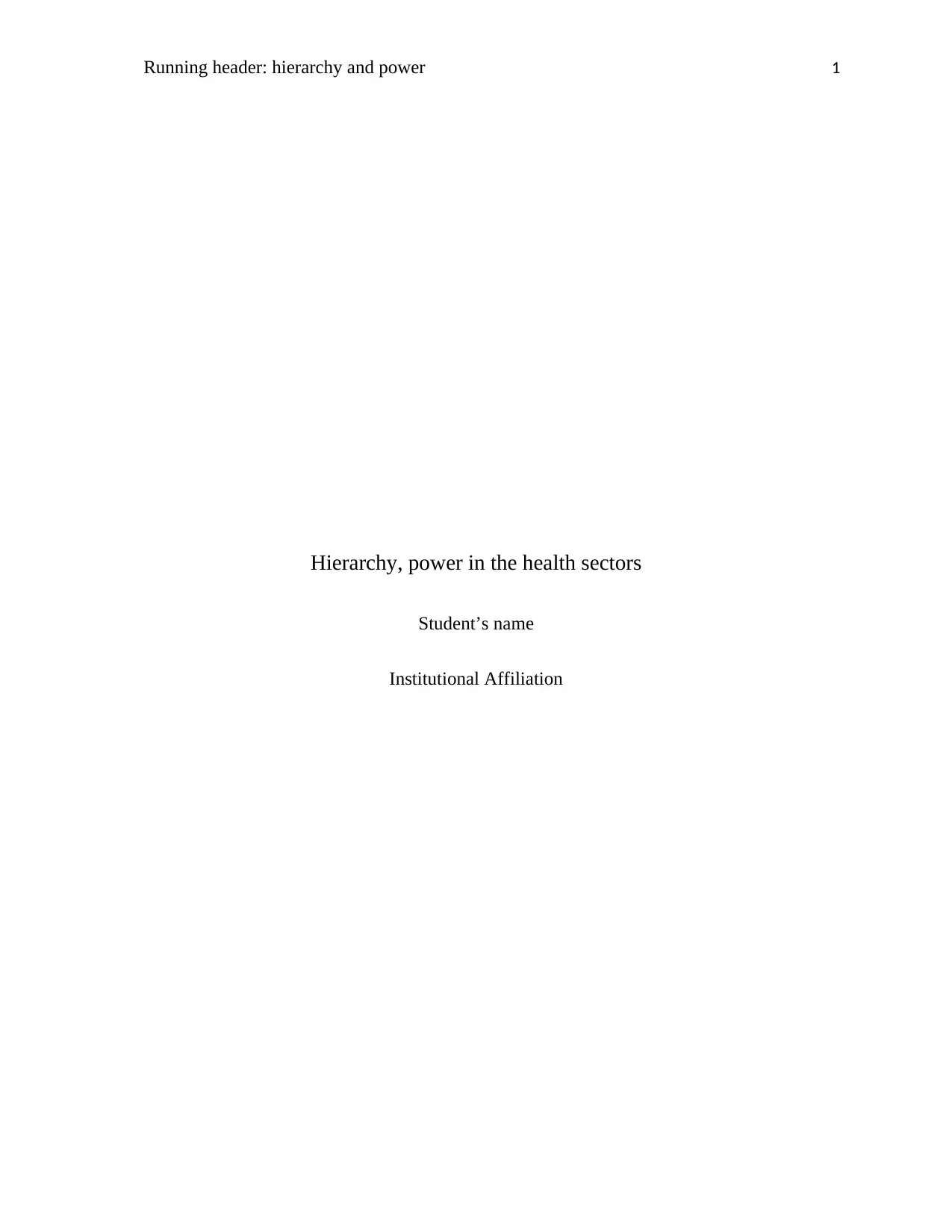
Running header: hierarchy and power 1
Hierarchy, power in the health sectors
Student’s name
Institutional Affiliation
Hierarchy, power in the health sectors
Student’s name
Institutional Affiliation
Paraphrase This Document
Need a fresh take? Get an instant paraphrase of this document with our AI Paraphraser
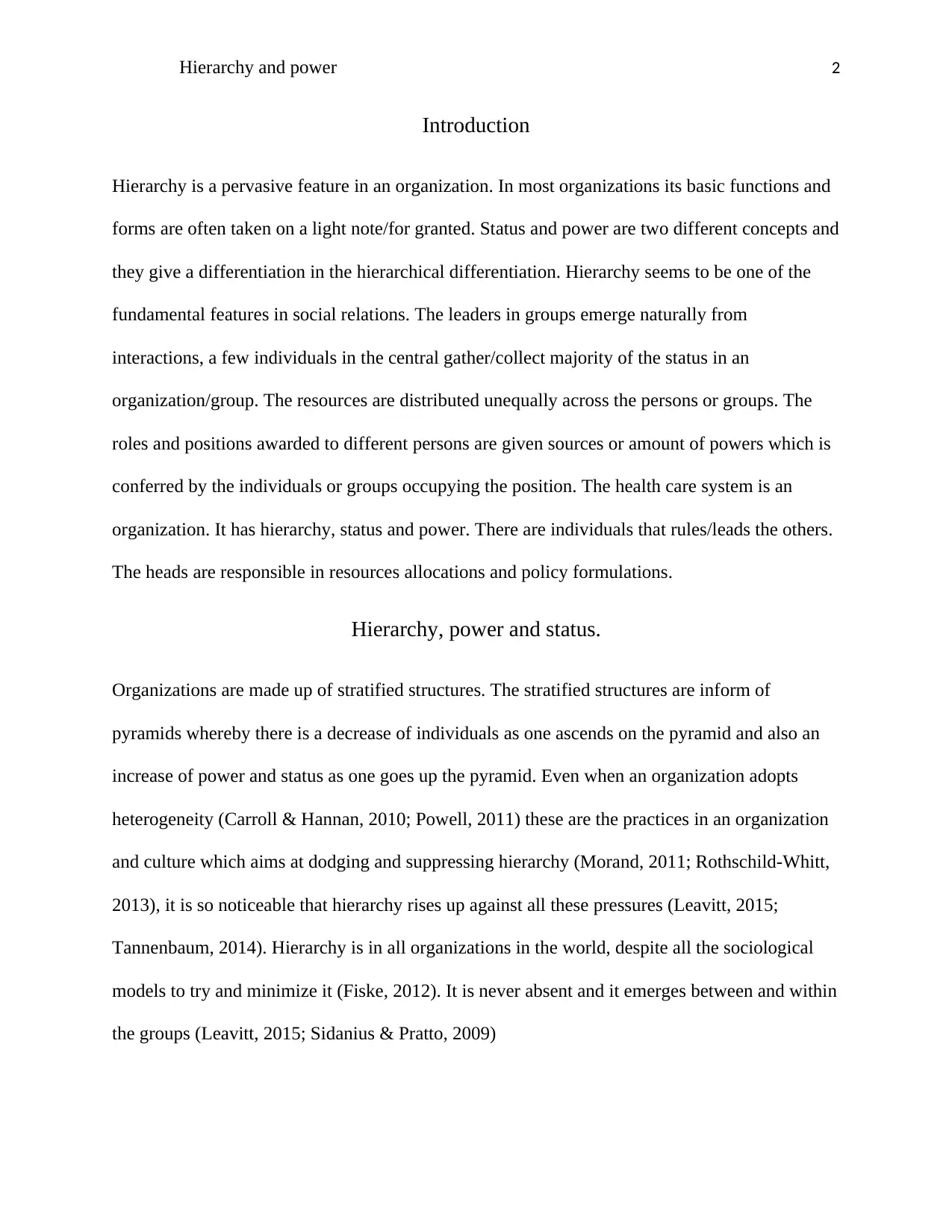
Hierarchy and power 2
Introduction
Hierarchy is a pervasive feature in an organization. In most organizations its basic functions and
forms are often taken on a light note/for granted. Status and power are two different concepts and
they give a differentiation in the hierarchical differentiation. Hierarchy seems to be one of the
fundamental features in social relations. The leaders in groups emerge naturally from
interactions, a few individuals in the central gather/collect majority of the status in an
organization/group. The resources are distributed unequally across the persons or groups. The
roles and positions awarded to different persons are given sources or amount of powers which is
conferred by the individuals or groups occupying the position. The health care system is an
organization. It has hierarchy, status and power. There are individuals that rules/leads the others.
The heads are responsible in resources allocations and policy formulations.
Hierarchy, power and status.
Organizations are made up of stratified structures. The stratified structures are inform of
pyramids whereby there is a decrease of individuals as one ascends on the pyramid and also an
increase of power and status as one goes up the pyramid. Even when an organization adopts
heterogeneity (Carroll & Hannan, 2010; Powell, 2011) these are the practices in an organization
and culture which aims at dodging and suppressing hierarchy (Morand, 2011; Rothschild-Whitt,
2013), it is so noticeable that hierarchy rises up against all these pressures (Leavitt, 2015;
Tannenbaum, 2014). Hierarchy is in all organizations in the world, despite all the sociological
models to try and minimize it (Fiske, 2012). It is never absent and it emerges between and within
the groups (Leavitt, 2015; Sidanius & Pratto, 2009)
Introduction
Hierarchy is a pervasive feature in an organization. In most organizations its basic functions and
forms are often taken on a light note/for granted. Status and power are two different concepts and
they give a differentiation in the hierarchical differentiation. Hierarchy seems to be one of the
fundamental features in social relations. The leaders in groups emerge naturally from
interactions, a few individuals in the central gather/collect majority of the status in an
organization/group. The resources are distributed unequally across the persons or groups. The
roles and positions awarded to different persons are given sources or amount of powers which is
conferred by the individuals or groups occupying the position. The health care system is an
organization. It has hierarchy, status and power. There are individuals that rules/leads the others.
The heads are responsible in resources allocations and policy formulations.
Hierarchy, power and status.
Organizations are made up of stratified structures. The stratified structures are inform of
pyramids whereby there is a decrease of individuals as one ascends on the pyramid and also an
increase of power and status as one goes up the pyramid. Even when an organization adopts
heterogeneity (Carroll & Hannan, 2010; Powell, 2011) these are the practices in an organization
and culture which aims at dodging and suppressing hierarchy (Morand, 2011; Rothschild-Whitt,
2013), it is so noticeable that hierarchy rises up against all these pressures (Leavitt, 2015;
Tannenbaum, 2014). Hierarchy is in all organizations in the world, despite all the sociological
models to try and minimize it (Fiske, 2012). It is never absent and it emerges between and within
the groups (Leavitt, 2015; Sidanius & Pratto, 2009)
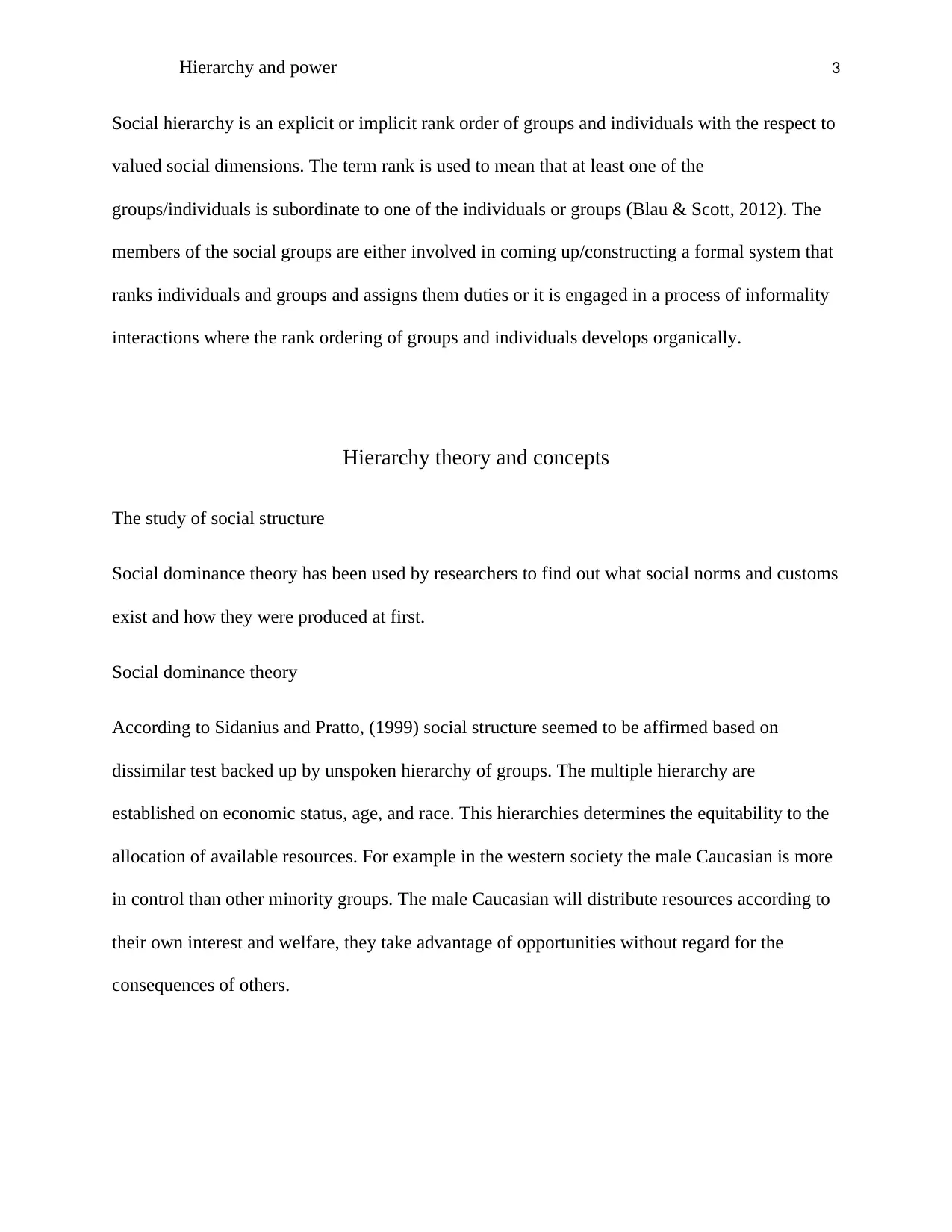
Hierarchy and power 3
Social hierarchy is an explicit or implicit rank order of groups and individuals with the respect to
valued social dimensions. The term rank is used to mean that at least one of the
groups/individuals is subordinate to one of the individuals or groups (Blau & Scott, 2012). The
members of the social groups are either involved in coming up/constructing a formal system that
ranks individuals and groups and assigns them duties or it is engaged in a process of informality
interactions where the rank ordering of groups and individuals develops organically.
Hierarchy theory and concepts
The study of social structure
Social dominance theory has been used by researchers to find out what social norms and customs
exist and how they were produced at first.
Social dominance theory
According to Sidanius and Pratto, (1999) social structure seemed to be affirmed based on
dissimilar test backed up by unspoken hierarchy of groups. The multiple hierarchy are
established on economic status, age, and race. This hierarchies determines the equitability to the
allocation of available resources. For example in the western society the male Caucasian is more
in control than other minority groups. The male Caucasian will distribute resources according to
their own interest and welfare, they take advantage of opportunities without regard for the
consequences of others.
Social hierarchy is an explicit or implicit rank order of groups and individuals with the respect to
valued social dimensions. The term rank is used to mean that at least one of the
groups/individuals is subordinate to one of the individuals or groups (Blau & Scott, 2012). The
members of the social groups are either involved in coming up/constructing a formal system that
ranks individuals and groups and assigns them duties or it is engaged in a process of informality
interactions where the rank ordering of groups and individuals develops organically.
Hierarchy theory and concepts
The study of social structure
Social dominance theory has been used by researchers to find out what social norms and customs
exist and how they were produced at first.
Social dominance theory
According to Sidanius and Pratto, (1999) social structure seemed to be affirmed based on
dissimilar test backed up by unspoken hierarchy of groups. The multiple hierarchy are
established on economic status, age, and race. This hierarchies determines the equitability to the
allocation of available resources. For example in the western society the male Caucasian is more
in control than other minority groups. The male Caucasian will distribute resources according to
their own interest and welfare, they take advantage of opportunities without regard for the
consequences of others.
⊘ This is a preview!⊘
Do you want full access?
Subscribe today to unlock all pages.

Trusted by 1+ million students worldwide
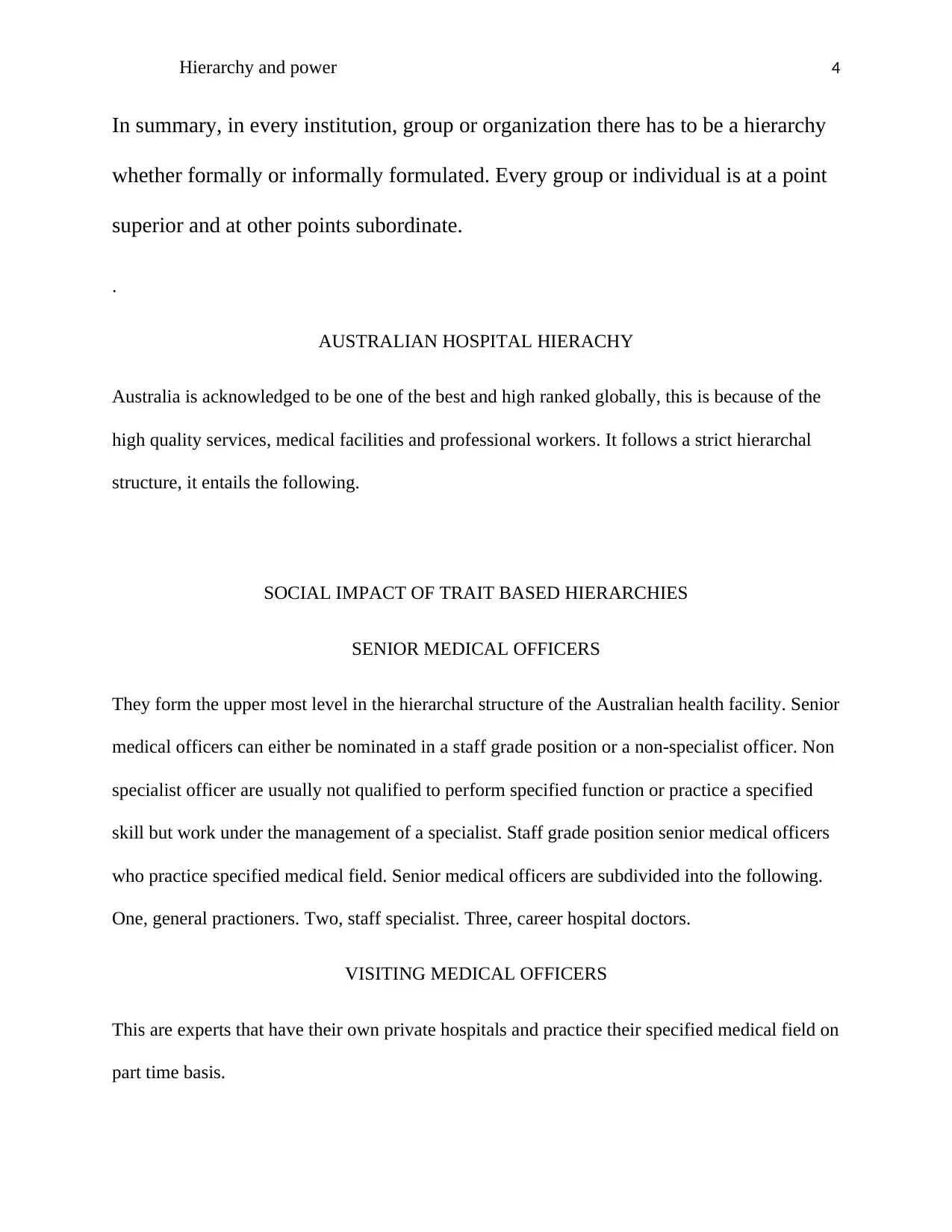
Hierarchy and power 4
In summary, in every institution, group or organization there has to be a hierarchy
whether formally or informally formulated. Every group or individual is at a point
superior and at other points subordinate.
.
AUSTRALIAN HOSPITAL HIERACHY
Australia is acknowledged to be one of the best and high ranked globally, this is because of the
high quality services, medical facilities and professional workers. It follows a strict hierarchal
structure, it entails the following.
SOCIAL IMPACT OF TRAIT BASED HIERARCHIES
SENIOR MEDICAL OFFICERS
They form the upper most level in the hierarchal structure of the Australian health facility. Senior
medical officers can either be nominated in a staff grade position or a non-specialist officer. Non
specialist officer are usually not qualified to perform specified function or practice a specified
skill but work under the management of a specialist. Staff grade position senior medical officers
who practice specified medical field. Senior medical officers are subdivided into the following.
One, general practioners. Two, staff specialist. Three, career hospital doctors.
VISITING MEDICAL OFFICERS
This are experts that have their own private hospitals and practice their specified medical field on
part time basis.
In summary, in every institution, group or organization there has to be a hierarchy
whether formally or informally formulated. Every group or individual is at a point
superior and at other points subordinate.
.
AUSTRALIAN HOSPITAL HIERACHY
Australia is acknowledged to be one of the best and high ranked globally, this is because of the
high quality services, medical facilities and professional workers. It follows a strict hierarchal
structure, it entails the following.
SOCIAL IMPACT OF TRAIT BASED HIERARCHIES
SENIOR MEDICAL OFFICERS
They form the upper most level in the hierarchal structure of the Australian health facility. Senior
medical officers can either be nominated in a staff grade position or a non-specialist officer. Non
specialist officer are usually not qualified to perform specified function or practice a specified
skill but work under the management of a specialist. Staff grade position senior medical officers
who practice specified medical field. Senior medical officers are subdivided into the following.
One, general practioners. Two, staff specialist. Three, career hospital doctors.
VISITING MEDICAL OFFICERS
This are experts that have their own private hospitals and practice their specified medical field on
part time basis.
Paraphrase This Document
Need a fresh take? Get an instant paraphrase of this document with our AI Paraphraser
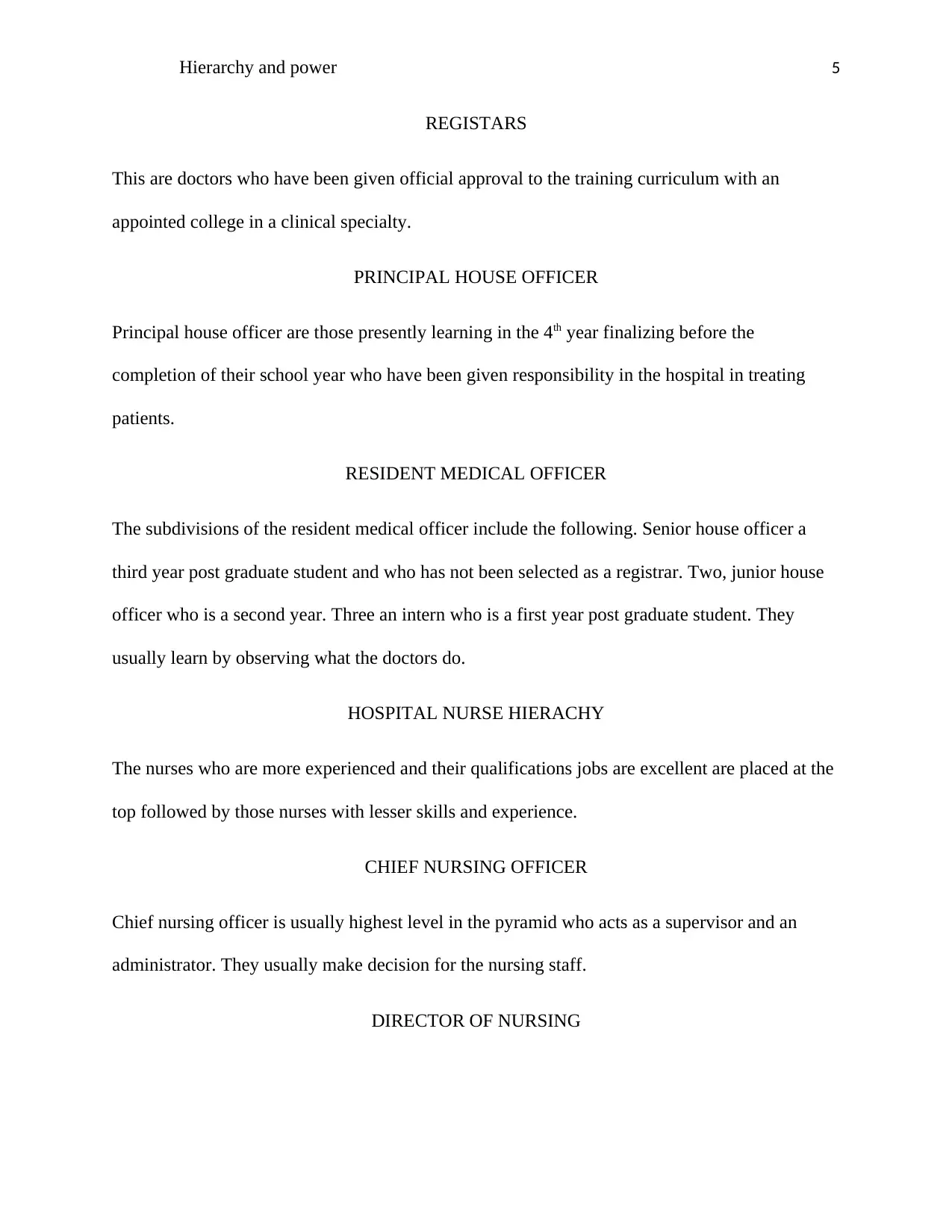
Hierarchy and power 5
REGISTARS
This are doctors who have been given official approval to the training curriculum with an
appointed college in a clinical specialty.
PRINCIPAL HOUSE OFFICER
Principal house officer are those presently learning in the 4th year finalizing before the
completion of their school year who have been given responsibility in the hospital in treating
patients.
RESIDENT MEDICAL OFFICER
The subdivisions of the resident medical officer include the following. Senior house officer a
third year post graduate student and who has not been selected as a registrar. Two, junior house
officer who is a second year. Three an intern who is a first year post graduate student. They
usually learn by observing what the doctors do.
HOSPITAL NURSE HIERACHY
The nurses who are more experienced and their qualifications jobs are excellent are placed at the
top followed by those nurses with lesser skills and experience.
CHIEF NURSING OFFICER
Chief nursing officer is usually highest level in the pyramid who acts as a supervisor and an
administrator. They usually make decision for the nursing staff.
DIRECTOR OF NURSING
REGISTARS
This are doctors who have been given official approval to the training curriculum with an
appointed college in a clinical specialty.
PRINCIPAL HOUSE OFFICER
Principal house officer are those presently learning in the 4th year finalizing before the
completion of their school year who have been given responsibility in the hospital in treating
patients.
RESIDENT MEDICAL OFFICER
The subdivisions of the resident medical officer include the following. Senior house officer a
third year post graduate student and who has not been selected as a registrar. Two, junior house
officer who is a second year. Three an intern who is a first year post graduate student. They
usually learn by observing what the doctors do.
HOSPITAL NURSE HIERACHY
The nurses who are more experienced and their qualifications jobs are excellent are placed at the
top followed by those nurses with lesser skills and experience.
CHIEF NURSING OFFICER
Chief nursing officer is usually highest level in the pyramid who acts as a supervisor and an
administrator. They usually make decision for the nursing staff.
DIRECTOR OF NURSING
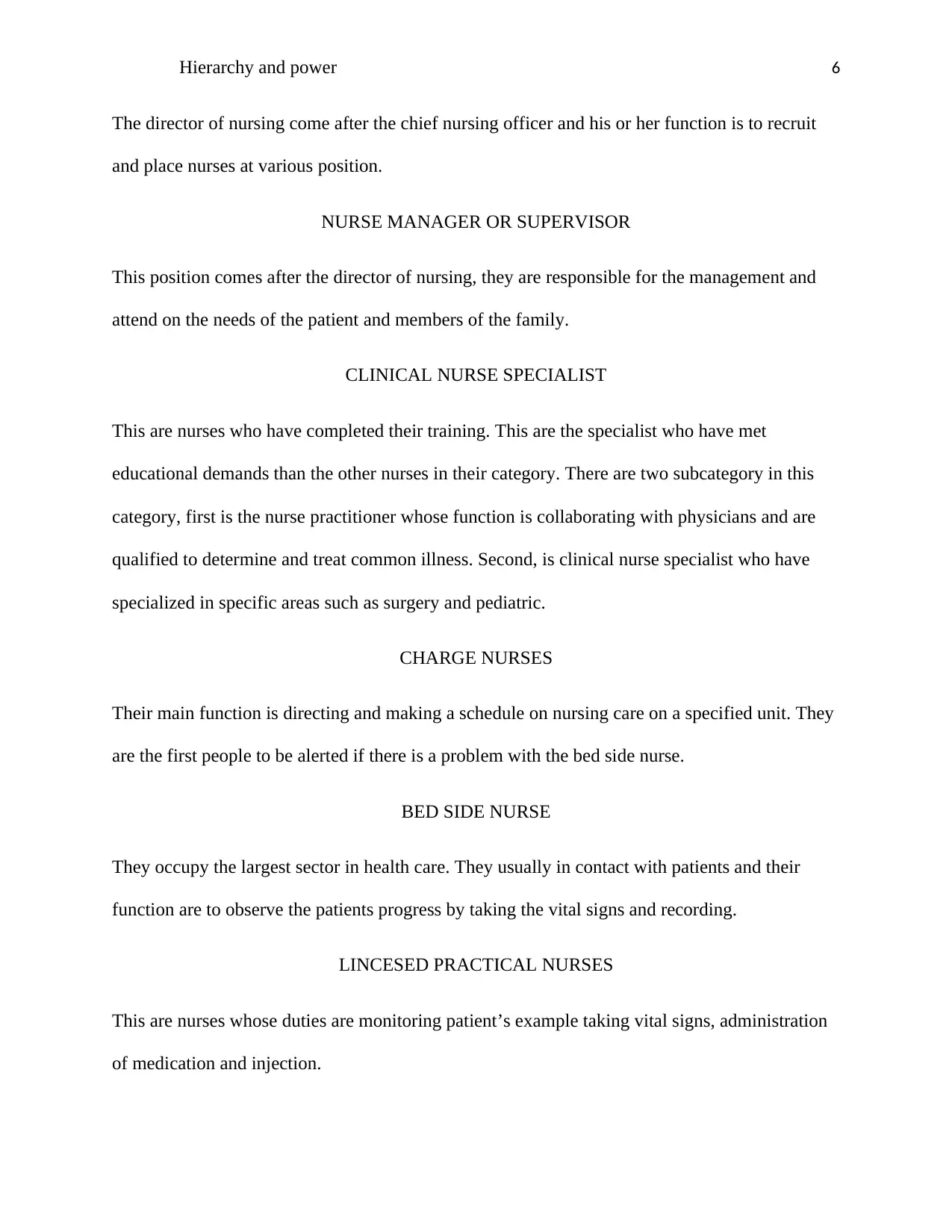
Hierarchy and power 6
The director of nursing come after the chief nursing officer and his or her function is to recruit
and place nurses at various position.
NURSE MANAGER OR SUPERVISOR
This position comes after the director of nursing, they are responsible for the management and
attend on the needs of the patient and members of the family.
CLINICAL NURSE SPECIALIST
This are nurses who have completed their training. This are the specialist who have met
educational demands than the other nurses in their category. There are two subcategory in this
category, first is the nurse practitioner whose function is collaborating with physicians and are
qualified to determine and treat common illness. Second, is clinical nurse specialist who have
specialized in specific areas such as surgery and pediatric.
CHARGE NURSES
Their main function is directing and making a schedule on nursing care on a specified unit. They
are the first people to be alerted if there is a problem with the bed side nurse.
BED SIDE NURSE
They occupy the largest sector in health care. They usually in contact with patients and their
function are to observe the patients progress by taking the vital signs and recording.
LINCESED PRACTICAL NURSES
This are nurses whose duties are monitoring patient’s example taking vital signs, administration
of medication and injection.
The director of nursing come after the chief nursing officer and his or her function is to recruit
and place nurses at various position.
NURSE MANAGER OR SUPERVISOR
This position comes after the director of nursing, they are responsible for the management and
attend on the needs of the patient and members of the family.
CLINICAL NURSE SPECIALIST
This are nurses who have completed their training. This are the specialist who have met
educational demands than the other nurses in their category. There are two subcategory in this
category, first is the nurse practitioner whose function is collaborating with physicians and are
qualified to determine and treat common illness. Second, is clinical nurse specialist who have
specialized in specific areas such as surgery and pediatric.
CHARGE NURSES
Their main function is directing and making a schedule on nursing care on a specified unit. They
are the first people to be alerted if there is a problem with the bed side nurse.
BED SIDE NURSE
They occupy the largest sector in health care. They usually in contact with patients and their
function are to observe the patients progress by taking the vital signs and recording.
LINCESED PRACTICAL NURSES
This are nurses whose duties are monitoring patient’s example taking vital signs, administration
of medication and injection.
⊘ This is a preview!⊘
Do you want full access?
Subscribe today to unlock all pages.

Trusted by 1+ million students worldwide
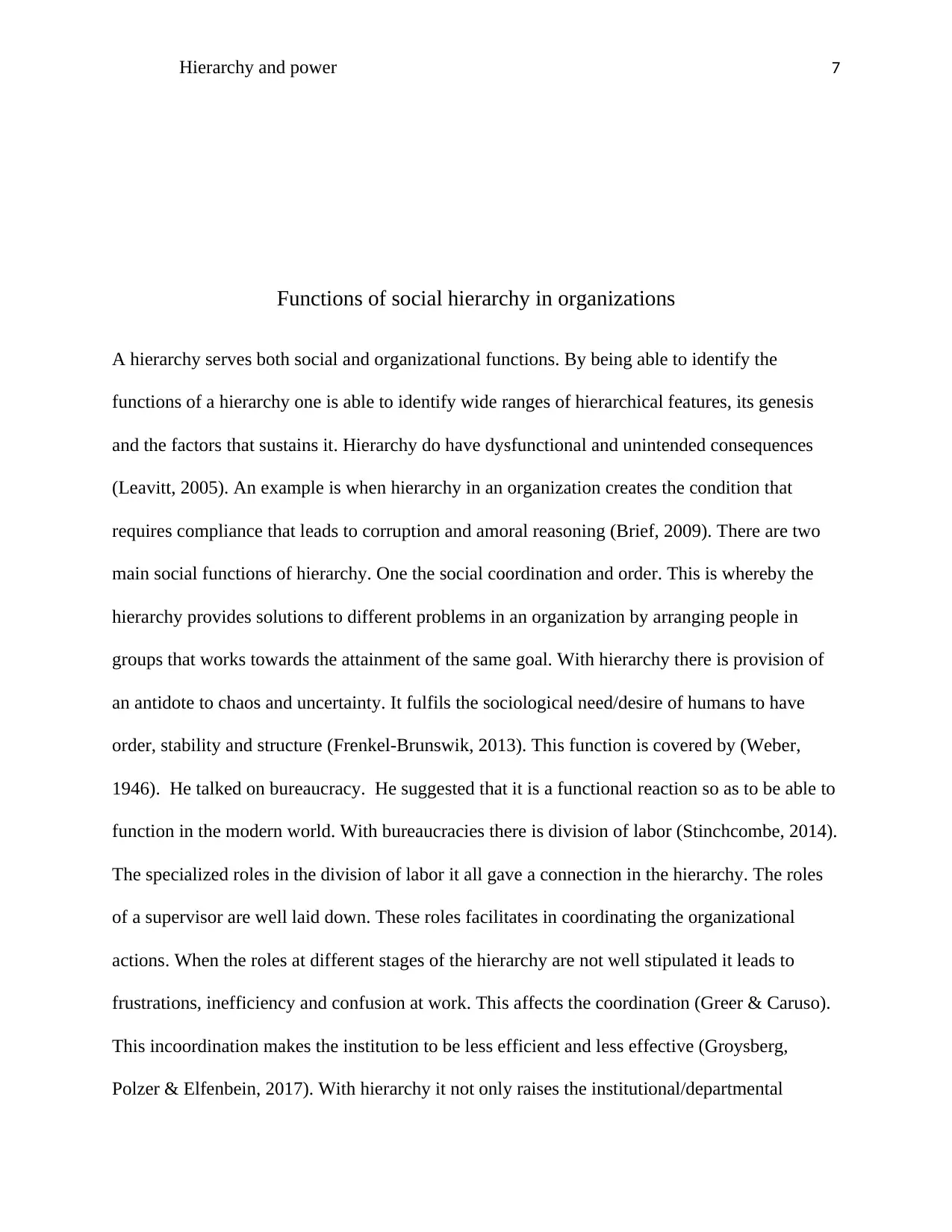
Hierarchy and power 7
Functions of social hierarchy in organizations
A hierarchy serves both social and organizational functions. By being able to identify the
functions of a hierarchy one is able to identify wide ranges of hierarchical features, its genesis
and the factors that sustains it. Hierarchy do have dysfunctional and unintended consequences
(Leavitt, 2005). An example is when hierarchy in an organization creates the condition that
requires compliance that leads to corruption and amoral reasoning (Brief, 2009). There are two
main social functions of hierarchy. One the social coordination and order. This is whereby the
hierarchy provides solutions to different problems in an organization by arranging people in
groups that works towards the attainment of the same goal. With hierarchy there is provision of
an antidote to chaos and uncertainty. It fulfils the sociological need/desire of humans to have
order, stability and structure (Frenkel-Brunswik, 2013). This function is covered by (Weber,
1946). He talked on bureaucracy. He suggested that it is a functional reaction so as to be able to
function in the modern world. With bureaucracies there is division of labor (Stinchcombe, 2014).
The specialized roles in the division of labor it all gave a connection in the hierarchy. The roles
of a supervisor are well laid down. These roles facilitates in coordinating the organizational
actions. When the roles at different stages of the hierarchy are not well stipulated it leads to
frustrations, inefficiency and confusion at work. This affects the coordination (Greer & Caruso).
This incoordination makes the institution to be less efficient and less effective (Groysberg,
Polzer & Elfenbein, 2017). With hierarchy it not only raises the institutional/departmental
Functions of social hierarchy in organizations
A hierarchy serves both social and organizational functions. By being able to identify the
functions of a hierarchy one is able to identify wide ranges of hierarchical features, its genesis
and the factors that sustains it. Hierarchy do have dysfunctional and unintended consequences
(Leavitt, 2005). An example is when hierarchy in an organization creates the condition that
requires compliance that leads to corruption and amoral reasoning (Brief, 2009). There are two
main social functions of hierarchy. One the social coordination and order. This is whereby the
hierarchy provides solutions to different problems in an organization by arranging people in
groups that works towards the attainment of the same goal. With hierarchy there is provision of
an antidote to chaos and uncertainty. It fulfils the sociological need/desire of humans to have
order, stability and structure (Frenkel-Brunswik, 2013). This function is covered by (Weber,
1946). He talked on bureaucracy. He suggested that it is a functional reaction so as to be able to
function in the modern world. With bureaucracies there is division of labor (Stinchcombe, 2014).
The specialized roles in the division of labor it all gave a connection in the hierarchy. The roles
of a supervisor are well laid down. These roles facilitates in coordinating the organizational
actions. When the roles at different stages of the hierarchy are not well stipulated it leads to
frustrations, inefficiency and confusion at work. This affects the coordination (Greer & Caruso).
This incoordination makes the institution to be less efficient and less effective (Groysberg,
Polzer & Elfenbein, 2017). With hierarchy it not only raises the institutional/departmental
Paraphrase This Document
Need a fresh take? Get an instant paraphrase of this document with our AI Paraphraser
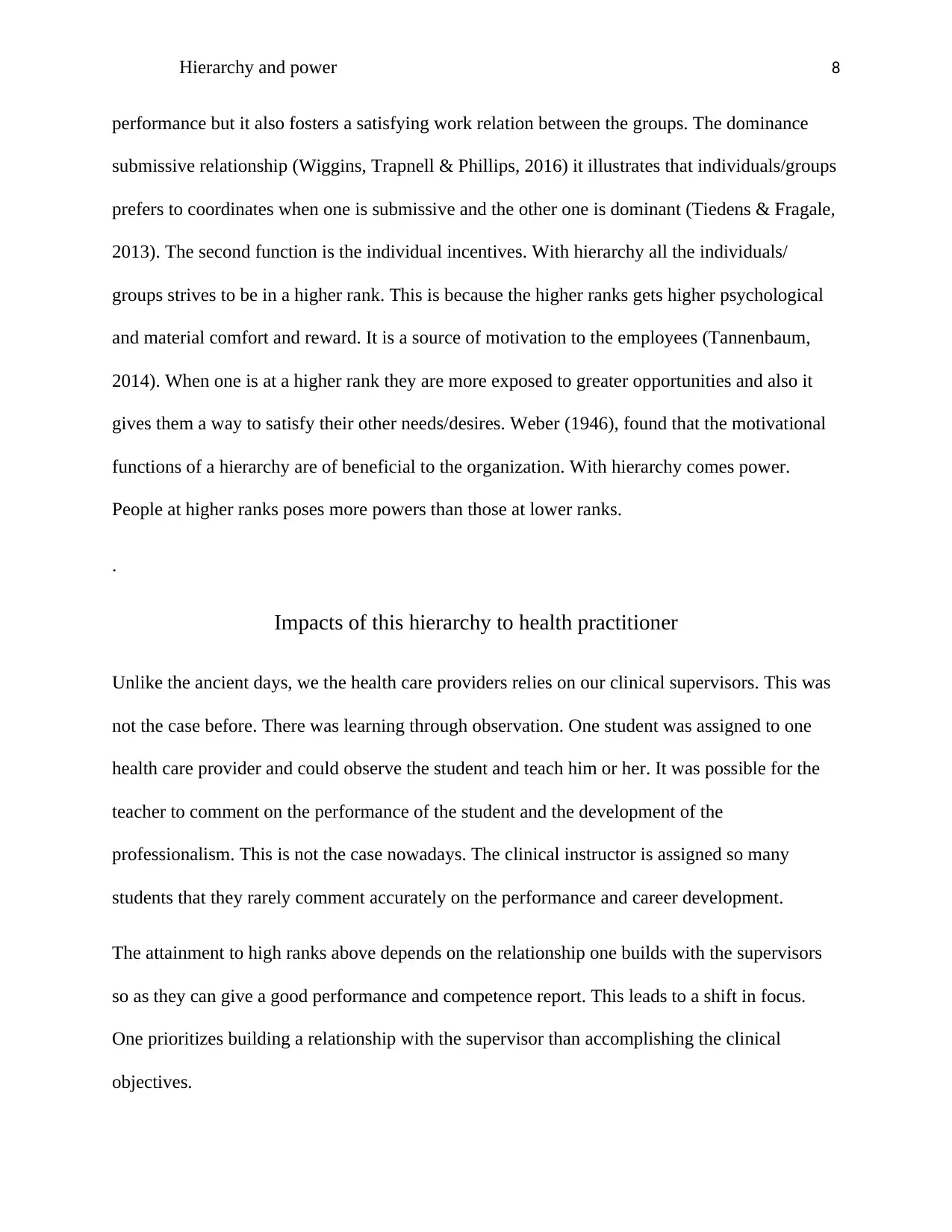
Hierarchy and power 8
performance but it also fosters a satisfying work relation between the groups. The dominance
submissive relationship (Wiggins, Trapnell & Phillips, 2016) it illustrates that individuals/groups
prefers to coordinates when one is submissive and the other one is dominant (Tiedens & Fragale,
2013). The second function is the individual incentives. With hierarchy all the individuals/
groups strives to be in a higher rank. This is because the higher ranks gets higher psychological
and material comfort and reward. It is a source of motivation to the employees (Tannenbaum,
2014). When one is at a higher rank they are more exposed to greater opportunities and also it
gives them a way to satisfy their other needs/desires. Weber (1946), found that the motivational
functions of a hierarchy are of beneficial to the organization. With hierarchy comes power.
People at higher ranks poses more powers than those at lower ranks.
.
Impacts of this hierarchy to health practitioner
Unlike the ancient days, we the health care providers relies on our clinical supervisors. This was
not the case before. There was learning through observation. One student was assigned to one
health care provider and could observe the student and teach him or her. It was possible for the
teacher to comment on the performance of the student and the development of the
professionalism. This is not the case nowadays. The clinical instructor is assigned so many
students that they rarely comment accurately on the performance and career development.
The attainment to high ranks above depends on the relationship one builds with the supervisors
so as they can give a good performance and competence report. This leads to a shift in focus.
One prioritizes building a relationship with the supervisor than accomplishing the clinical
objectives.
performance but it also fosters a satisfying work relation between the groups. The dominance
submissive relationship (Wiggins, Trapnell & Phillips, 2016) it illustrates that individuals/groups
prefers to coordinates when one is submissive and the other one is dominant (Tiedens & Fragale,
2013). The second function is the individual incentives. With hierarchy all the individuals/
groups strives to be in a higher rank. This is because the higher ranks gets higher psychological
and material comfort and reward. It is a source of motivation to the employees (Tannenbaum,
2014). When one is at a higher rank they are more exposed to greater opportunities and also it
gives them a way to satisfy their other needs/desires. Weber (1946), found that the motivational
functions of a hierarchy are of beneficial to the organization. With hierarchy comes power.
People at higher ranks poses more powers than those at lower ranks.
.
Impacts of this hierarchy to health practitioner
Unlike the ancient days, we the health care providers relies on our clinical supervisors. This was
not the case before. There was learning through observation. One student was assigned to one
health care provider and could observe the student and teach him or her. It was possible for the
teacher to comment on the performance of the student and the development of the
professionalism. This is not the case nowadays. The clinical instructor is assigned so many
students that they rarely comment accurately on the performance and career development.
The attainment to high ranks above depends on the relationship one builds with the supervisors
so as they can give a good performance and competence report. This leads to a shift in focus.
One prioritizes building a relationship with the supervisor than accomplishing the clinical
objectives.
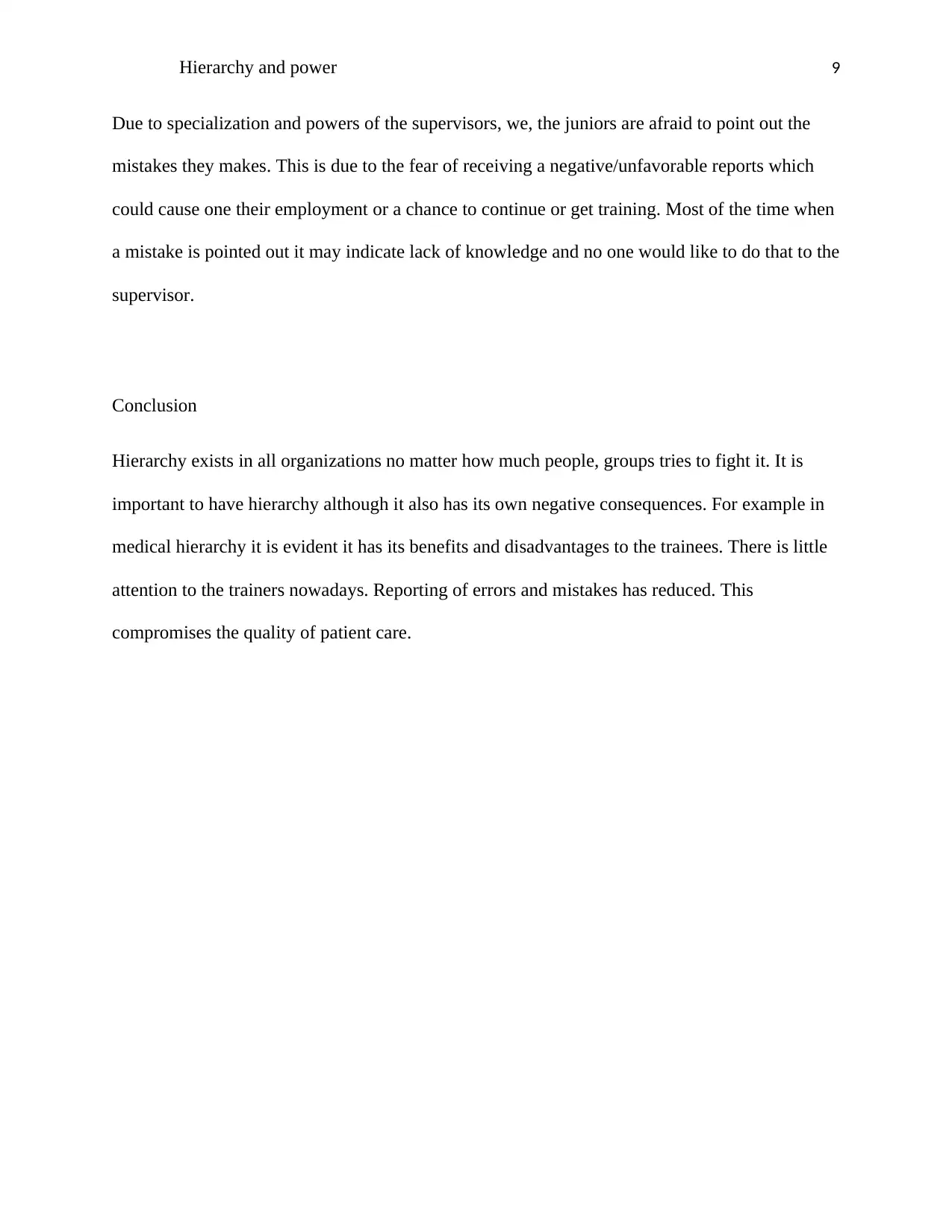
Hierarchy and power 9
Due to specialization and powers of the supervisors, we, the juniors are afraid to point out the
mistakes they makes. This is due to the fear of receiving a negative/unfavorable reports which
could cause one their employment or a chance to continue or get training. Most of the time when
a mistake is pointed out it may indicate lack of knowledge and no one would like to do that to the
supervisor.
Conclusion
Hierarchy exists in all organizations no matter how much people, groups tries to fight it. It is
important to have hierarchy although it also has its own negative consequences. For example in
medical hierarchy it is evident it has its benefits and disadvantages to the trainees. There is little
attention to the trainers nowadays. Reporting of errors and mistakes has reduced. This
compromises the quality of patient care.
Due to specialization and powers of the supervisors, we, the juniors are afraid to point out the
mistakes they makes. This is due to the fear of receiving a negative/unfavorable reports which
could cause one their employment or a chance to continue or get training. Most of the time when
a mistake is pointed out it may indicate lack of knowledge and no one would like to do that to the
supervisor.
Conclusion
Hierarchy exists in all organizations no matter how much people, groups tries to fight it. It is
important to have hierarchy although it also has its own negative consequences. For example in
medical hierarchy it is evident it has its benefits and disadvantages to the trainees. There is little
attention to the trainers nowadays. Reporting of errors and mistakes has reduced. This
compromises the quality of patient care.
⊘ This is a preview!⊘
Do you want full access?
Subscribe today to unlock all pages.

Trusted by 1+ million students worldwide
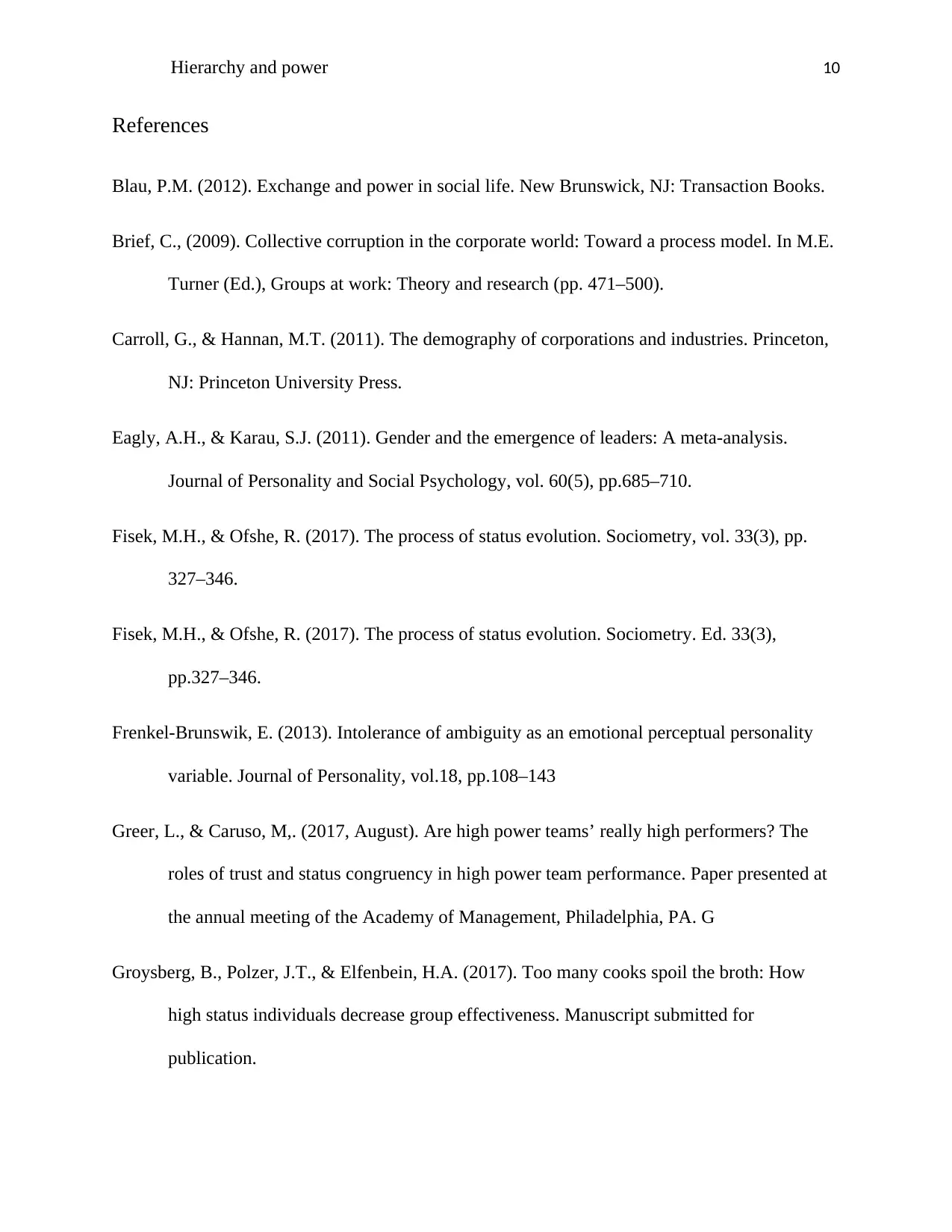
Hierarchy and power 10
References
Blau, P.M. (2012). Exchange and power in social life. New Brunswick, NJ: Transaction Books.
Brief, C., (2009). Collective corruption in the corporate world: Toward a process model. In M.E.
Turner (Ed.), Groups at work: Theory and research (pp. 471–500).
Carroll, G., & Hannan, M.T. (2011). The demography of corporations and industries. Princeton,
NJ: Princeton University Press.
Eagly, A.H., & Karau, S.J. (2011). Gender and the emergence of leaders: A meta-analysis.
Journal of Personality and Social Psychology, vol. 60(5), pp.685–710.
Fisek, M.H., & Ofshe, R. (2017). The process of status evolution. Sociometry, vol. 33(3), pp.
327–346.
Fisek, M.H., & Ofshe, R. (2017). The process of status evolution. Sociometry. Ed. 33(3),
pp.327–346.
Frenkel-Brunswik, E. (2013). Intolerance of ambiguity as an emotional perceptual personality
variable. Journal of Personality, vol.18, pp.108–143
Greer, L., & Caruso, M,. (2017, August). Are high power teams’ really high performers? The
roles of trust and status congruency in high power team performance. Paper presented at
the annual meeting of the Academy of Management, Philadelphia, PA. G
Groysberg, B., Polzer, J.T., & Elfenbein, H.A. (2017). Too many cooks spoil the broth: How
high status individuals decrease group effectiveness. Manuscript submitted for
publication.
References
Blau, P.M. (2012). Exchange and power in social life. New Brunswick, NJ: Transaction Books.
Brief, C., (2009). Collective corruption in the corporate world: Toward a process model. In M.E.
Turner (Ed.), Groups at work: Theory and research (pp. 471–500).
Carroll, G., & Hannan, M.T. (2011). The demography of corporations and industries. Princeton,
NJ: Princeton University Press.
Eagly, A.H., & Karau, S.J. (2011). Gender and the emergence of leaders: A meta-analysis.
Journal of Personality and Social Psychology, vol. 60(5), pp.685–710.
Fisek, M.H., & Ofshe, R. (2017). The process of status evolution. Sociometry, vol. 33(3), pp.
327–346.
Fisek, M.H., & Ofshe, R. (2017). The process of status evolution. Sociometry. Ed. 33(3),
pp.327–346.
Frenkel-Brunswik, E. (2013). Intolerance of ambiguity as an emotional perceptual personality
variable. Journal of Personality, vol.18, pp.108–143
Greer, L., & Caruso, M,. (2017, August). Are high power teams’ really high performers? The
roles of trust and status congruency in high power team performance. Paper presented at
the annual meeting of the Academy of Management, Philadelphia, PA. G
Groysberg, B., Polzer, J.T., & Elfenbein, H.A. (2017). Too many cooks spoil the broth: How
high status individuals decrease group effectiveness. Manuscript submitted for
publication.
Paraphrase This Document
Need a fresh take? Get an instant paraphrase of this document with our AI Paraphraser
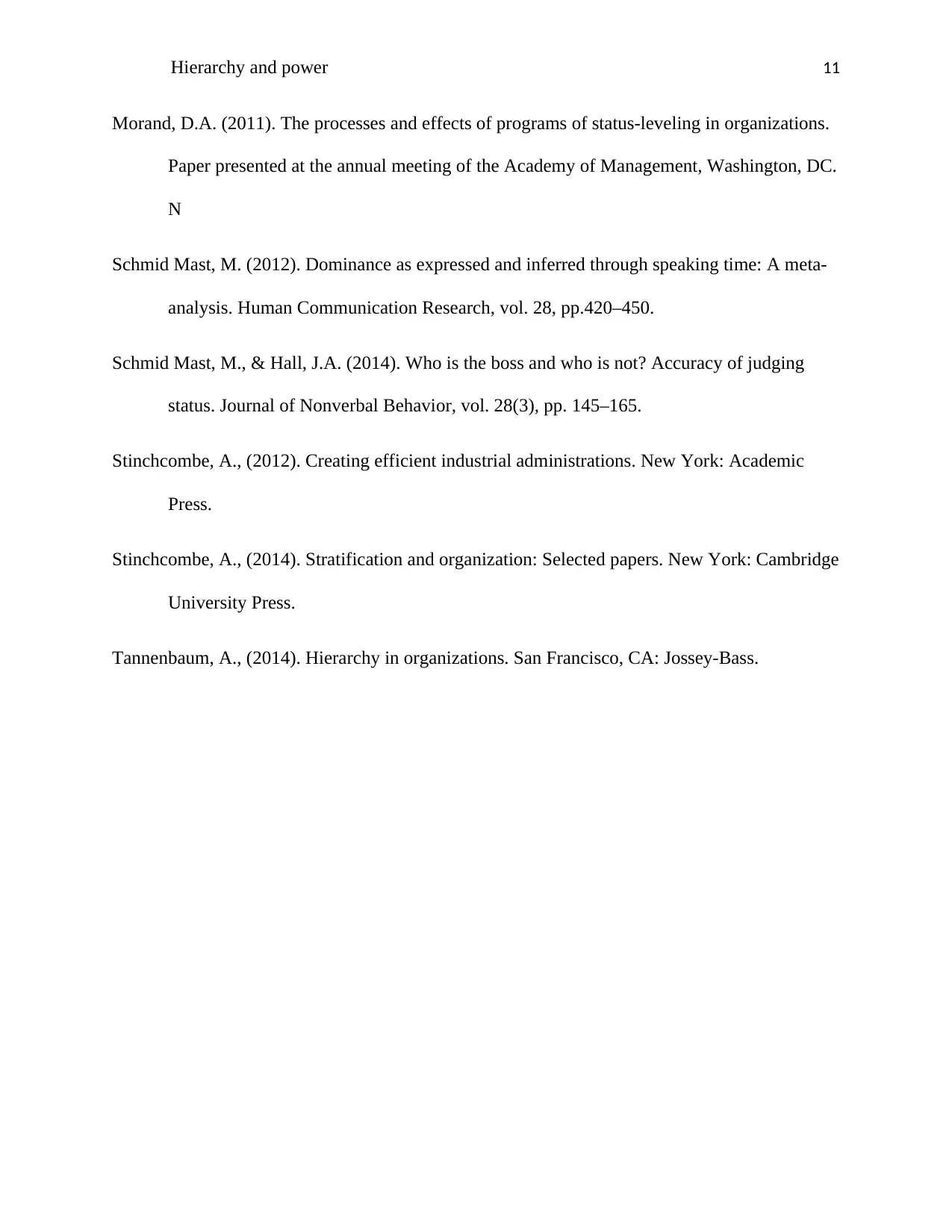
Hierarchy and power 11
Morand, D.A. (2011). The processes and effects of programs of status-leveling in organizations.
Paper presented at the annual meeting of the Academy of Management, Washington, DC.
N
Schmid Mast, M. (2012). Dominance as expressed and inferred through speaking time: A meta-
analysis. Human Communication Research, vol. 28, pp.420–450.
Schmid Mast, M., & Hall, J.A. (2014). Who is the boss and who is not? Accuracy of judging
status. Journal of Nonverbal Behavior, vol. 28(3), pp. 145–165.
Stinchcombe, A., (2012). Creating efficient industrial administrations. New York: Academic
Press.
Stinchcombe, A., (2014). Stratification and organization: Selected papers. New York: Cambridge
University Press.
Tannenbaum, A., (2014). Hierarchy in organizations. San Francisco, CA: Jossey-Bass.
Morand, D.A. (2011). The processes and effects of programs of status-leveling in organizations.
Paper presented at the annual meeting of the Academy of Management, Washington, DC.
N
Schmid Mast, M. (2012). Dominance as expressed and inferred through speaking time: A meta-
analysis. Human Communication Research, vol. 28, pp.420–450.
Schmid Mast, M., & Hall, J.A. (2014). Who is the boss and who is not? Accuracy of judging
status. Journal of Nonverbal Behavior, vol. 28(3), pp. 145–165.
Stinchcombe, A., (2012). Creating efficient industrial administrations. New York: Academic
Press.
Stinchcombe, A., (2014). Stratification and organization: Selected papers. New York: Cambridge
University Press.
Tannenbaum, A., (2014). Hierarchy in organizations. San Francisco, CA: Jossey-Bass.
1 out of 11
Related Documents
Your All-in-One AI-Powered Toolkit for Academic Success.
+13062052269
info@desklib.com
Available 24*7 on WhatsApp / Email
![[object Object]](/_next/static/media/star-bottom.7253800d.svg)
Unlock your academic potential
Copyright © 2020–2025 A2Z Services. All Rights Reserved. Developed and managed by ZUCOL.





